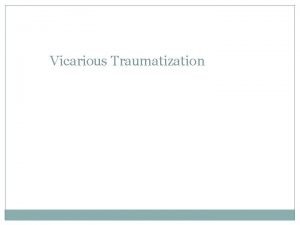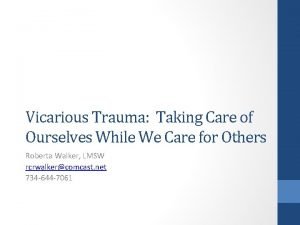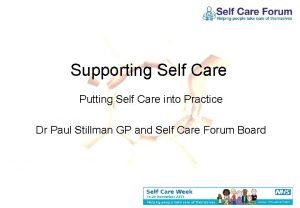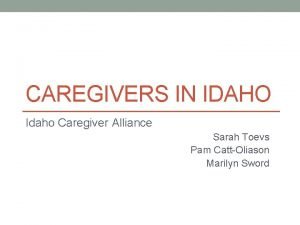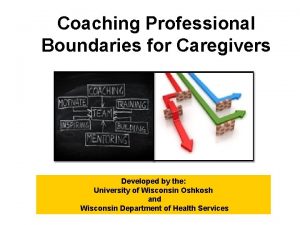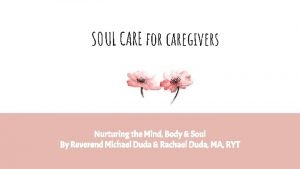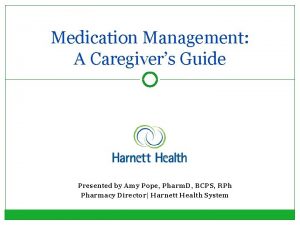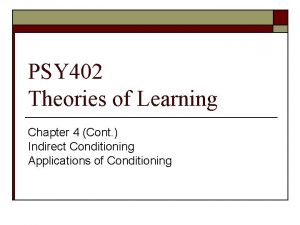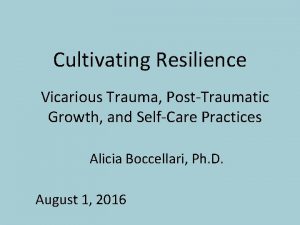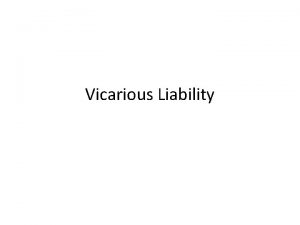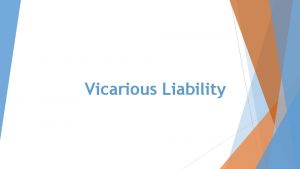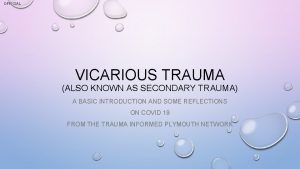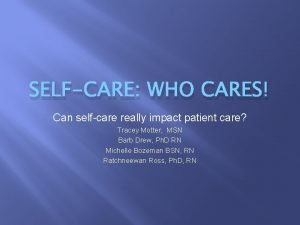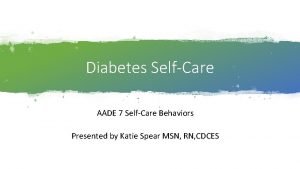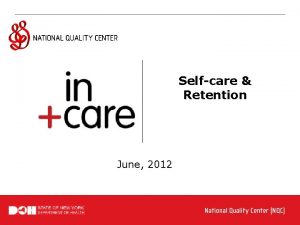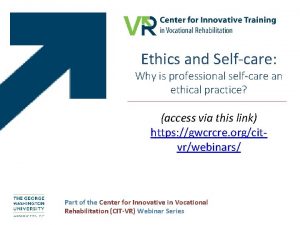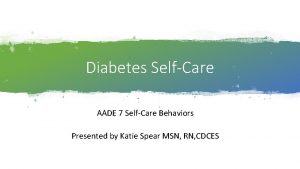Transforming Vicarious Trauma SelfCare for Caregivers www leapsf













- Slides: 13

Transforming Vicarious Trauma: Self-Care for Caregivers www. leapsf. org

Goals To understand what is meant by the process of “vicarious trauma” (VT) n To engage in self-reflection and selfassessment about the impact n To begin to conceptualize coping strategies to work proactively with sources of strain n

Vicarious Trauma (VT) n Vicarious Trauma is the process of change that happens because you care about the people you serve. Over time, this can lead to changes in your psychological, physical, and spiritual life that also affect your family, your organization, and your patients/clients. Pearlman, L. A. & Mc. Kay, L. (2008). Understanding and addressing vicarious trauma. www. heading-institute. org

Self-Diagnostic Check: How Are You Today?

Mindfulness Reflection Exercise n Who were you when you decided to be a public health caregiver? n How have the stories you’ve heard and the suffering you’ve witnessed affected you?

Risk Factors n n n n Early career and later career risks may vary Greater similarity to patients served and/or personal trauma history Volume and severity of patient presentations Personal temperament Higher levels of life stress Not yet fully developed personal coping repertoire, support systems, and spiritual beliefs Organizational context unsupportive

Common Adverse Effects n Body/Physiological: ¨ ¨ ¨ Insomnia Fatigue, exhaustion Numbness, body disconnection Appetite and weight changes General somatic distress and poor health Hypervigilance: constantly on-guard for danger n Emotional/Feeling: Feeling shocked or horrified ¨ Persistent unwanted emotional overwhelm including sadness, anxiety, and/or irritability ¨ Numbness and emotional overdetachment ¨ Absence of positive emotions: happiness, humor, enjoyment. ¨

n Thoughts/Beliefs: ¨ ¨ ¨ Repetitive, obsessive thoughts or images Distracted, forgetful Rigid, black-or-white thinking Loss of ideals can lead to depression, despair, and pessimism Negatively-altered beliefs about the self, others, and the world (themes: meaninglessness, fear, distrust). n Behavior: ¨ ¨ ¨ Isolate professionally and/or personally Avoid reminders of what is painful or uncomfortable Inflexibility or “overflexibility” of boundaries Conflicts with others where attributions and anger may be displaced Imbalanced work contribution: over or under.

Are VT Effects All Bad? How has this work strengthened you? n What meaning do you derive from serving others who have been hurt? n What lessons have you learned about survival, resilience, and positive transformation? (“vicarious resilience”) n

The Best Coping Plans. . . n n n Respect your temperament, preferences, reactions, and lifestyle, all of which change over time. Involve active strategies that require investment of your time and energy even when you feel you have neither. Balance: ¨ Escape: ¨ Rest: ¨ Play: Simply getting away physically, mentally Activities with no goal or timeline Fun, creative, positive energy.

Additional Coping Tips n n Daily rituals that take only a moment can be helpful Building and reaching out to social supports that understand the strain you are under and support you in ways you prefer Coaching and praising self: gentleness, affirmation, acceptance, positive reframing Creation of strong organizational culture

The Struggle for Meaning: Despair vs. Optimism Despair/ Helplessness I don’t matter. I don’t make a difference. I am alone/the only one. I give up. Optimism/ Hopefulness I am important. I make a difference. I have support. I can do this.

Training and materials were created by. . . n n n Greg Merrill, LCSW in collaboration with LEAP www. leapsf. org Funded by a grant from San Francisco Kaiser Permanente Community Benefits Foundation
 Robyn bradey vicarious trauma
Robyn bradey vicarious trauma Secondary traumatization definition
Secondary traumatization definition Vicarious traumatisation
Vicarious traumatisation Libby whittaker
Libby whittaker Charis melina
Charis melina Uni due wiing prüfungsamt
Uni due wiing prüfungsamt Sun direct selfcare
Sun direct selfcare Professional boundaries for in home caregivers
Professional boundaries for in home caregivers Idaho caregiver alliance
Idaho caregiver alliance Observing professional boundaries for caregivers
Observing professional boundaries for caregivers Polyvagal
Polyvagal First aid for caregivers
First aid for caregivers Caregivers guide to medication
Caregivers guide to medication Vicarious reinforcement
Vicarious reinforcement

